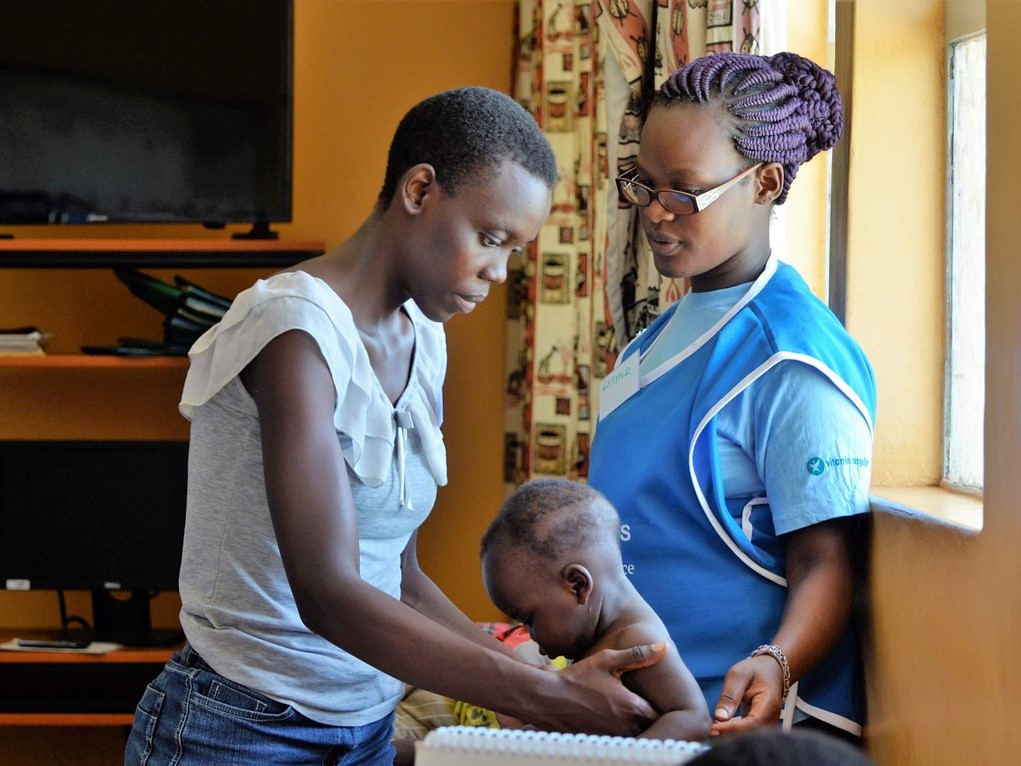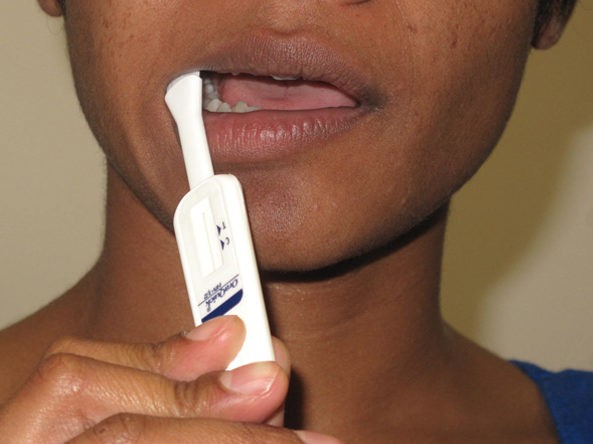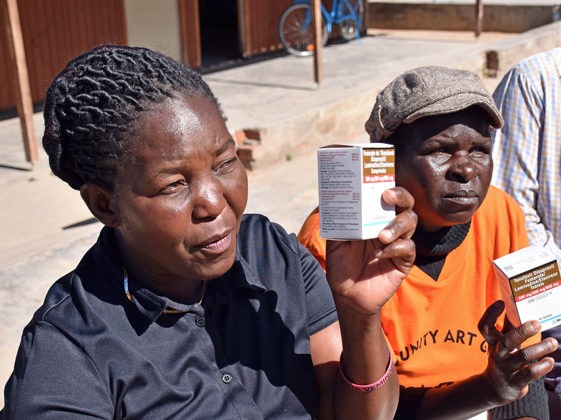Article and Study Summary:
Risk-based versus universal PrEP delivery during pregnancy: a cluster randomized trial in Western Kenya from 2018 to 2019
Published in:
J Int AIDS Soc. 2023;26(2):e26061.
https://onlinelibrary.wiley.com/doi/10.1002/jia2.26061
Authors:
Kinuthia J, Dettinger JC, Stern J, et al.
Summary
Pregnancy and breastfeeding are periods of increased risk of HIV acquisition, and women who acquire HIV during these periods are at higher risk of vertical transmission compared to those with chronic HIV disease. This study was a cluster randomized trial assessing two models of PrEP delivery for pregnant women in routine maternal and child health (MCH) care: a universal or targeted offer of PrEP. Participants at clinics randomized to the Universal arm received standardized PrEP counselling and decided whether to initiate PrEP. Participants at clinics randomized to the Targeted arm underwent an HIV risk assessment, including an objective risk-scoring tool, and were provided HIV self-test kits (HIVST) for at-home partner testing; those determined to be at substantial risk were offered PrEP. The study enrolled 4,447 women and followed them through nine months postpartum. At study end, analysis found no significant difference in HIV incidence or the frequency of appropriate PrEP use between arms. Acceptance of HIVST for partners was high, as was partner use of HIVST. Knowing their partner’s status influenced PrEP decision-making for some participants. Given similar outcomes in both arms and the relative simplicity of the Universal arm approach to offering PrEP in MCH settings, the authors conclude that universal PrEP counselling is optimal for integrating PrEP in MCH systems. Including the offer of HIVST for partners may aid MCH clients to make decisions regarding PrEP use.
Discussion Questions:
1) Is universal offer of PrEP offer feasible in the MCH and other service delivery settings you support? What modifications to routine service flow would facilitate a universal approach?
2) What, if any, policy changes would support a universal approach?
Please share your thoughts and experiences with us in the comments section below.
Full Synopsis:
PDF version available in English, French, Spanish, and Portuguese.
Study Summary
Pregnancy and breastfeeding are periods of increased risk of HIV acquisition, and women who acquire HIV during these periods are at higher risk of vertical transmission compared to those with chronic HIV disease. The PrEP Implementation for Mothers in Antenatal Care (PrIMA) study was a cluster randomized trial assessing two models of PrEP delivery for pregnant women seeking routine maternal and child health (MCH) care, implemented between January 2018 and July 2019. Participants at clinics randomized to the Universal arm received standardized PrEP counselling and decided whether to initiate PrEP. Participants at clinics randomized to the Targeted arm underwent an HIV risk assessment, including an objective risk-scoring tool, and were provided HIV self-test kits (HIVST) for at-home partner testing; those determined to be at substantial risk were offered PrEP. The study enrolled 4,447 women and followed them through nine months postpartum. At the end of study follow up, data analysis found no significant difference in the frequency of appropriate PrEP use between the arms. Given this outcome and the relative simplicity of the Universal arm approach to offering PrEP in MCH settings the authors conclude that universal PrEP counselling is optimal for integrating PrEP in MCH systems.
Study Setting
Twenty public MCH clinics in two Lake Victoria counties in Kenya, Siaya and Homa Bay counties.
Methods
- MCH clinics were eligible for inclusion if they had >350 HIV-negative annual antenatal care clinic (ANC) clients and offered postnatal care.
- Clinics were randomized to Universal or Targeted PrEP counselling, stratified by ANC volume and county.
- Participant eligibility criteria included: pregnant at enrollment, HIV negative as documented in MCH records during the ANC visit, not currently using PrEP, ≥15 years old, tuberculosis negative, planning to reside in the area for ≥1-year postpartum and to receive postnatal care at the study facility, and not enrolled in any other studies. Those with creatinine clearance (CrCl) ≤50 milliliter per minute or hepatitis B surface antigen positivity were ineligible for PrEP per national guidelines.
- At Universal arm clinics, consenting participants received PrEP counselling using a standardized script that listed risk factors for HIV acquisition and considerations for PrEP use, after which participants decided whether to initiate PrEP. Those wishing to initiate were assessed for eligibility using national tools and procedures. Universal arm participants could elect to initiate and be assessed for PrEP at enrollment or at subsequent study visits.
- At Targeted arm clinics, consenting participants underwent an HIV risk assessment adapted from Kenyan national guidelines and a tool shown to predict HIV risk in pregnant and postpartum women in similar settings in Kenya. Under national guidelines, individuals who had experienced any of the following in the previous six months were eligible for PrEP: transactional sex, a diagnosis or treatment for a sexually transmitted infection (STI), forced sex, physical assault, shared needles during intravenous drug use, and >2 courses of post-exposure prophylaxis. Participants with any risk factor under national guidelines or who scored >6 on the additional tool were considered at high risk. Participants determined to be at high risk received standardized PrEP counselling and were offered PrEP. Any woman who requested it was provided PrEP regardless of risk status. Participants were also offered HIV self-test kits (HIVST) for partners, to provide information on partner HIV status to guide PrEP decision-making. Women were counselled to not accept or offer HIVST to their partners if concerned about physical, emotional, or other repercussions of doing so. Women were asked at follow-up visits about their partner’s HIVST results and whether they had changed their decision about PrEP use.
- At enrollment, participants completed interviewer-administered questionnaires assessing sociodemographic characteristics, mental health, intimate partner violence, PrEP knowledge, and partner HIV status. Gestational age at enrollment was assessed using last menstrual period (97.9% of participants) or fundal height (2.1%). Syphilis testing was conducted through rapid plasma reagin during the first ANC visit; if results were not available in the medical record at enrollment, testing was performed using SD Bioline HIV/Syphilis Duo test kits.
- Participants were followed through 9 months postpartum at monthly ANC visits and at 6-week, 14-week, 6-month and 9-month postnatal visits. Visits aligned with national recommendations for antenatal and infant immunization visits.
- Self-reported PrEP adherence in the preceding 30 days was assessed at follow-up visits when participants confirmed that they had started taking PrEP.
- Participants received HIV testing according to the national HIV testing algorithm at all study visits.
- The primary outcomes were maternal HIV incidence and appropriate PrEP use. HIV incidence was defined as confirmed maternal HIV infections per 100 person-years of follow-up. Appropriate PrEP use was defined as the proportion of participants at high risk accepting PrEP, and those at low risk declining PrEP.
- Primary analyses were intention to treat. All analyses included clustering by facility. Adjusted models included baseline HIV risk status, marital status, and time in study.
- Secondary outcomes included PrEP acceptance, initiation, adherence, and duration, and partner HIV status at nine months postpartum. PrEP acceptance was defined as participants who accepted PrEP at any visit. PrEP confirmation was defined as participant-report of taking PrEP pills at visits after acceptance; PrEP initiation date was defined as the median date between PrEP acceptance and confirmation visits. At the PrEP confirmation visit, self-reported PrEP adherence was dichotomized as no missed doses versus any missed doses in the past 30 days. PrEP duration was defined as the time between the PrEP initiation date and discontinuation or study end.
Study Population and Follow-Up
- Between January 2018 and July 2019 8,427 women were screened, of whom 4,447 were enrolled (2,250 in the Universal arm and 2,197 in the Targeted arm).
- The median age of participants was 24.0 years (interquartile range [IQR] 20.9, 28.3). More than half of the participants were < 25 years old (57.3%), and most (84.8%) were currently married. Median gestational age at enrollment was 24 weeks (IQR 20, 30) and the majority (74.4%) of participants had been pregnant previously.
- Overall, 42.3% of participants met criteria for being at high risk of HIV acquisition; 9.5% of women had symptoms of moderate-to-severe depression and 7.8% reported intimate partner violence.
- Women in the Targeted arm clinics were more likely to be married, know someone on PrEP, have depressive symptoms and be at high risk for HIV acquisition than women in the Universal arm (51.6% versus 33.3%, respectively).
- Only two participants were medically ineligible for PrEP, both due to a hepatitis B diagnosis.
- Study retention was 94%, with no differences between arms reported.
Results
Primary Outcomes
- During 4,638 person-years (py) of follow-up, 16 maternal HIV infections occurred; an overall HIV incidence of 0.35 infections/100 py (95% confidence interval [CI]: 0.21, 0.56).
- HIV incidence in the two arms was similar: seven incident maternal HIV infections (0.31/100 py [CI: 0.15, 0.65]) in the Targeted arm and nine incident infections (0.38/100 py [CI: 0.20, 0.73]) in the Universal arm. The adjusted relative risk (aRR) for HIV incidence in the Targeted versus Universal arm was 0.85 (CI: 0.28, 2.55, p = 0.77).
- Overall, 2834 (63.7%) participants had an appropriate PrEP decision, with non-significantly lower frequency in the Targeted than Universal arm (59.1% vs. 68.2%) (aRR: 1.03 [CI: 0.96, 1.10] p = 0.37).
- Among 1,883 women determined to be at high risk, 29.2% accepted PrEP; in the Targeted arm 311 (27.4%) women at risk accepted PrEP, which was lower than the 238 (31.7%) in the Universal arm accepting PrEP (aRR 0.87 [CI: 0.61–1.24] p = 0.43).
- Among women assessed as low risk, 76 (7.1%) of 1064 participants in the Targeted arm independently requested PrEP, a lower frequency than in the Universal arm (203/1500 [13.5%]) (aRR 0.52 [CI: 0.24–1.13] p = 0.10).
Secondary Outcomes
- Overall, 828 women (18.6%) accepted PrEP, with no significant difference between arms (aRR: 0.74 [CI: 0.50, 1.10] p = 0.14).
- Overall, 720 (16.2%) women initiated PrEP, with a trend towards statistical significance for a lower likelihood of PrEP initiation in the Targeted arm (aRR: 0.68 [CI: 0.46, 1.02] p = 0.062).
- Of those who initiated PrEP, the median duration of PrEP use was 9.0 months (IQR: 3.8, 11.9) in the Targeted arm and 8.6 months (IQR: 3.2, 11.4) in the Universal arm, with no difference between arms (adjusted risk difference: 0.11 [CI: –0.94, 1.15] p = 0.83).
- About half of those who initiated PrEP (49.3%) continued use throughout follow-up, with similar PrEP continuation in both arms (aRR: 0.93 [CI: 0.71, 1.22] p = 0.60.
- Just over half of participants (52.8% Universal, 62.5% Targeted) reported perfect PrEP adherence at their first study visit after accepting PrEP (aRR: 1.13 [CI: 0.91, 1.41] p = 0.28).
HIVST Uptake in the Targeted Arm
- In the Targeted arm, 1,384 (63.5%) accepted HIVST for partner HIV testing. Women who declined partner HIVST were more likely to have a partner with known HIV-positive status (10.3% declined versus 1.0% accepted, p<0.001) and reported older partners than those who accepted HIVST (median 31 vs. 30, p = 0.006).
- Among women who accepted HIVST, most (85.8%) offered the HIVST to their partners. Almost all (96.0%) reported their partners used the tests and among those, 98.9% reported seeing their partner’s results.
- HIVST results identified 12 (1.1%) partners with HIV-positive results. Partner HIVST results decreased the proportion of women with unknown partner status from 40.5% at baseline to 21.7% by nine months postpartum (p = 0.002) in the Targeted arm compared to the Universal arm where unknown partner status did not change (22.6–23.5%; p = 0.76)
- Among 157 women who initiated PrEP and reported a partner of unknown HIV status at baseline, 114 (72.6%) accepted HIVST for partner testing and 79 (69.3%) subsequently reported their partner was HIV negative. Of these 79 women, 49 (62.0%) discontinued PrEP following partner HIVST results.
- Of the 15 women whose partner was newly identified as HIV positive or indeterminate, five (33%) had initiated PrEP prior to HIVST results; five (33%) elected to start PrEP after HIVST results; and five (33%) did not start PrEP.
Participant Risk for HIV at 9 Months Postpartum
- Using updated partner HIV status information at 9 months postpartum to estimate risk status, 30.8% of women overall would be classified as high risk, 31.3% in the Targeted arm and 30.3% in the Universal arm. The proportion of women at high risk decreased from baseline (51.6%) to 9 months postpartum (31.3%) (p = 0.001) in the Targeted arm and from 33.3% to 30.3% in the Universal arm (p = 0.26).
- With the significant decrease in the proportion of Targeted arm participants defined as being at high risk at nine months postpartum, there was no longer an increased relative risk of a participant being at high risk at nine months postpartum between the Targeted and Universal arms (aRR: 0.85 [CI: 0.55–1.31] p: 0.46).
- Based on nine-month postpartum partner HIV status knowledge, the proportion who made appropriate PrEP decisions was 69.3% overall, 70.4% in the Targeted arm and 68.2% in the Universal arm (aRR: 1.09 [CI: 0.93–1.290 p = 0.28).
Critical Analysis
This cluster randomized controlled trial found that a risk-guided offer of PrEP in the Targeted arm was not superior to a Universal PrEP offer, based on HIV incidence and appropriate PrEP decisions among women attending MCH clinics in two high HIV prevalence counties in Kenya. HIV incidence was low in both arms, prevalence of appropriate PrEP decisions did not differ significantly between study arms, and PrEP continuation was high.
The following points should be considered when interpreting the study findings:
- Low HIV incidence in both arms limited power to compare one study primary outcome; however, the similarity in HIV incidence in both arms (0.38 and 0.31/100 person-years) suggests that meaningful differences between arms are unlikely.
- Lower maternal HIV incidence likely reflects wider population antiretroviral therapy use and PrEP use in the study cohort.
- PrEP services were offered in the context of routine MCH care, which strengthens the generalizability of study findings. However, rates of PrEP adherence and persistence could have been influenced by efforts to optimize study retention, and similar rates of PrEP use may not be achieved in routine settings outside of a research context.
- To assess PrEP initiation and adherence, and partner HIVST outcomes, the study relied on self-report, which is known to produce overestimates of health behaviors.
Implications
- The PrIMA study showed that HIV risk screening to identify candidates for PrEP in ANC settings did not impact HIV incidence or appropriate PrEP uptake compared to general counseling on PrEP for all ANC clients. General counseling may be conducted in group settings and by non-clinical providers, streamlining PrEP service delivery. It could also help reduce stigma if PrEP is universally offered instead of being targeted to certain clients.
- In the Targeted arm, acceptance of HIVST for partners was high (>60%), as was partner use of HIVST (>80%). Knowing their partner’s status influenced PrEP decision-making for some participants, highlighting the potential role of partner testing to complement a universal PrEP offer in ANC settings.
- The study found very low rates of ineligibility due to inadequate CrCl, reinforcing WHO’s 2022 recommendation that kidney function measurement can be considered optional for PrEP clients aged 30 years and younger with no kidney-related comorbidities. For clients aged 30–49 years without kidney-related comorbidities, measurement of kidney function can be considered optional as well, depending on available resources.
This article synopsis was written by Dr. Julie Franks. Share your thoughts on this article or suggest an article for Journal Club by emailing her at jf642@columbia.edu
Other articles of note:








